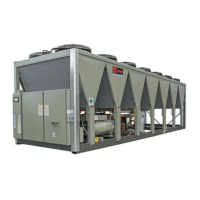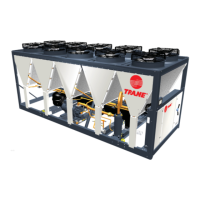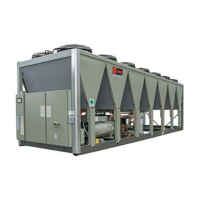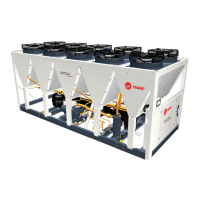Installation Mechanical
RTAF-SVX001K-EN 21
Isolation and Sound Emission
The most effective form of isolation is to locate the unit
away from any sound sensitive area. Structurally
transmitted sound can be reduced by elastomeric
vibration eliminators. Spring isolators are not
recommended. Consult an acoustical engineer in critical
sound applications.
For maximum isolation effect, isolate water lines and
electrical conduit. Wall sleeves and rubber isolated piping
hangers can be used to reduce the sound transmitted
through water piping. To reduce the sound transmitted
through electrical conduit, use flexible electrical conduit.
State and local codes on sound emissions should always
be considered. Since the environment in which a sound
source is located affects sound pressure, unit placement
must be carefully evaluated. Sound power levels for
Sintesis™ chillers are available on request.
Unit Isolation and Leveling
For additional reduction of sound and vibration, install the
optional elastomeric isolators.
Construct an isolated concrete pad for the unit or provide
concrete footings at the unit mounting points. Mount the
unit directly to the concrete pads or footings.
Level the unit using the base rail as a reference. The unit
must be level within 1/2 in (12 mm) over the entire length
and width. Use shims as necessary to level the unit.
Elastomeric Isolators
Note: See unit submittal, or Table 12, p. 23 thru Table 16,
p. 27 for point weights, isolator location and
isolator selections.
1. Secure the isolators to the mounting surface using the
mounting slots in the isolator base plate. Do not fully
tighten the isolator mounting bolts at this time.
2. Align the mounting holes in the base of the unit with
the threaded positioning pins on the top of the
isolators.
3. Lower the unit onto the isolators and secure the
isolator to the unit with a nut.
4. Level the unit carefully. Fully tighten the isolator
mounting bolts.
Elastomeric Isolation Pads for Windload
Option
Elastomeric pads ship inside the unit control panel. They
are provided with an isolation washer and 3/4” free hole in
the center of the plate.
Figure 8. Elastomeric isolator
Table 8. Isolator specifications
Type Color Ext Max Load (lbs) Max Deflection
RDP-4 Brown 61 1500 0.50
RDP-4 Red 62 2250 0.50
RDP-4 Lime 63 3000 0.50
RDP-4 Charcoal 64 4000 0.50
Figure 9. Seismic isolation pad — installed
Table 9. Seismically rated elastomeric isolation pad
Dimension (in)
Model Max Load Length Width Height
B-36 2520 6 6 0.625
0.50 in
1.60±0.25
Mounting molded in neoprene
3.0
2.75
0.38
1/2 - 13NC - 2B
0.56 in
5.0
4.63
6.25
Grade 8 Washer
Fender Washer
Isolation
Washer
Unit Base Rail
Steel
Plate
Isolation Pad
Grade 8 Bolt
Building Support Structure
Grade 8 Washer
Fender Washer
(Washers under support structure recommended
if job site has an I-beam or C-channel.)
Nut

